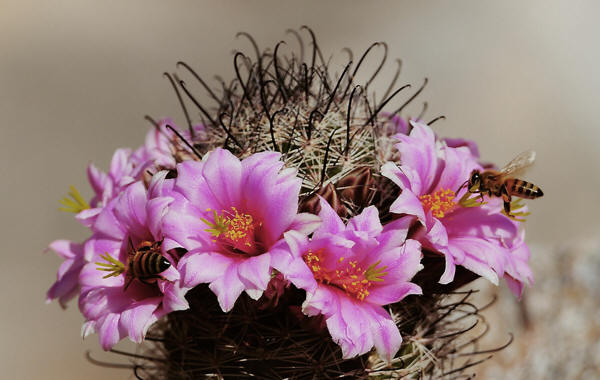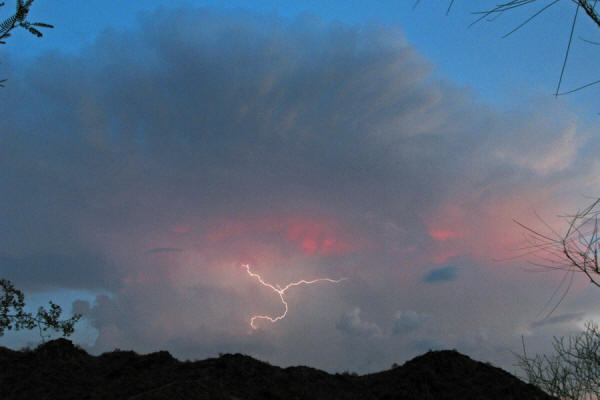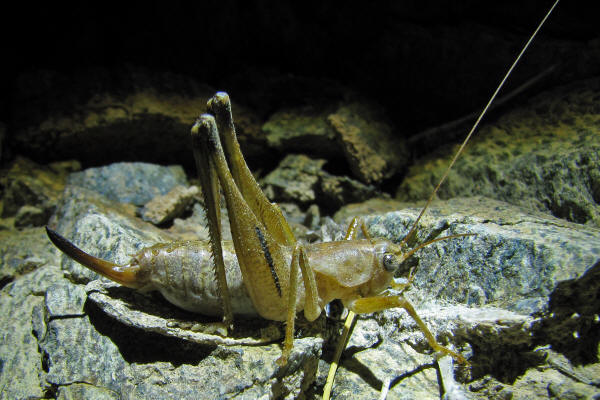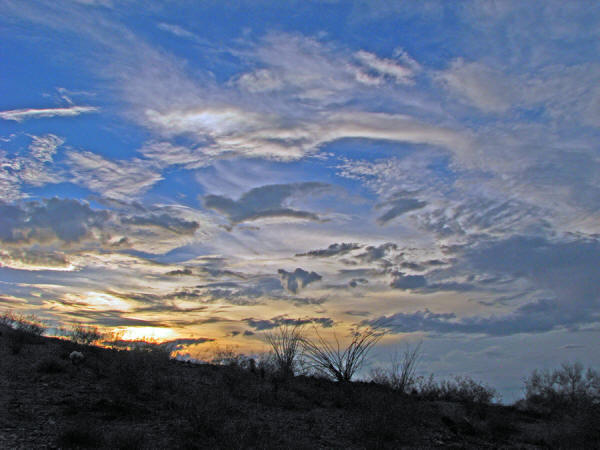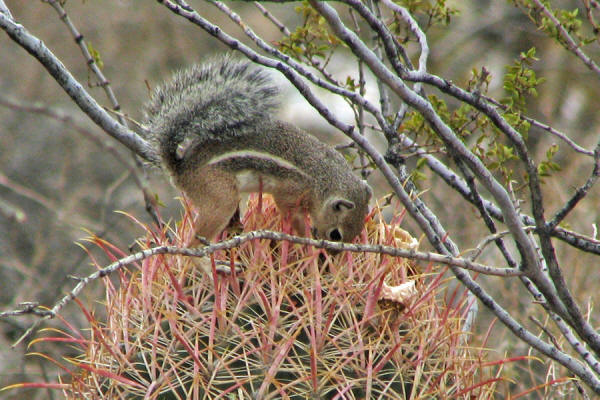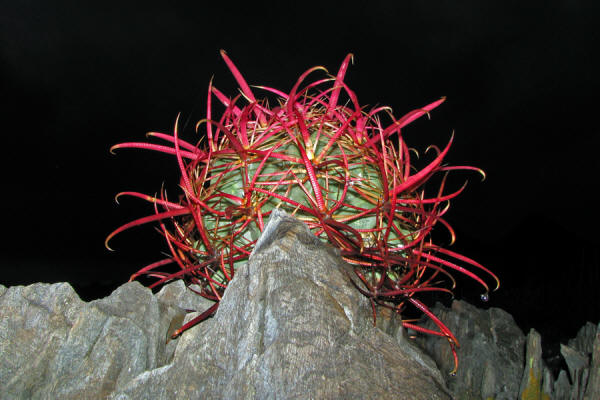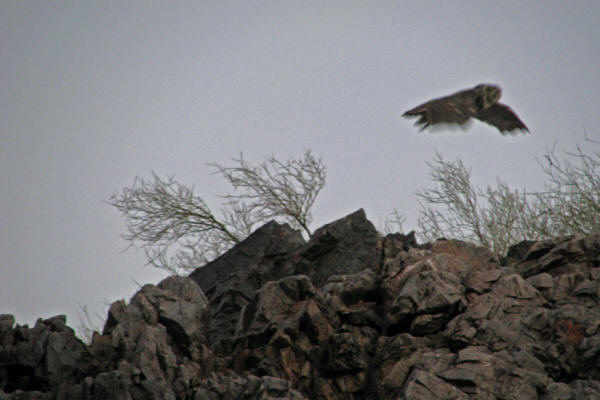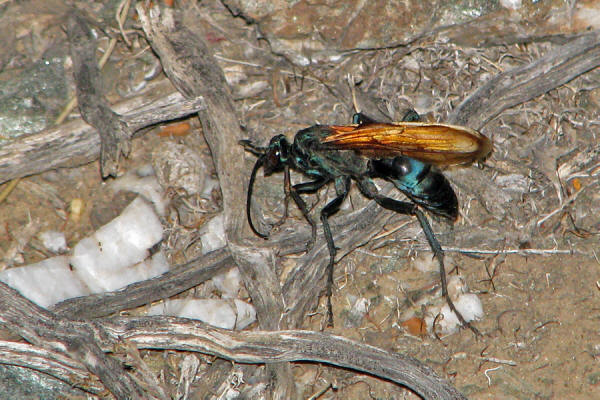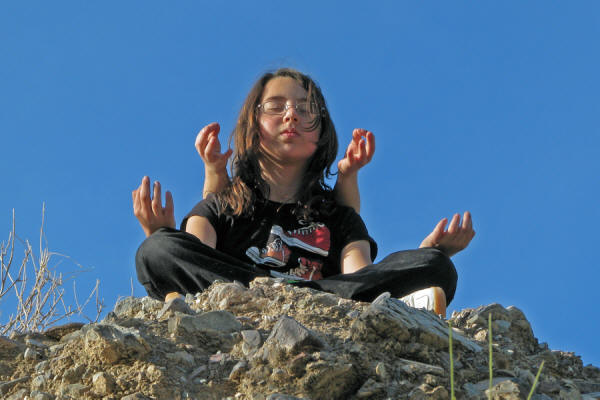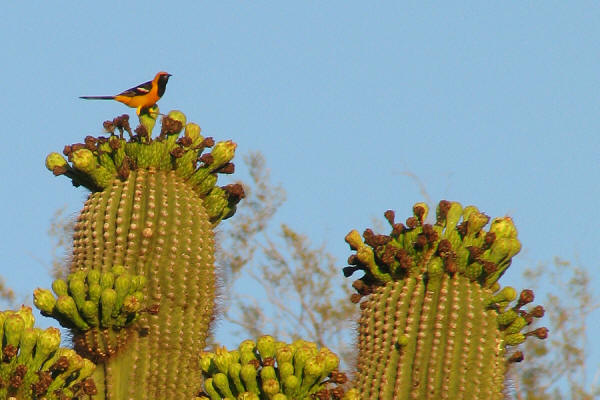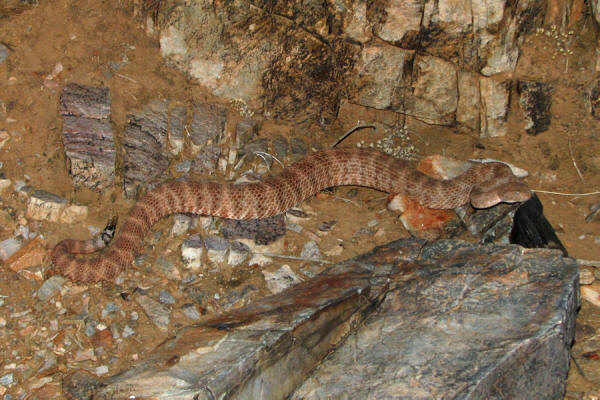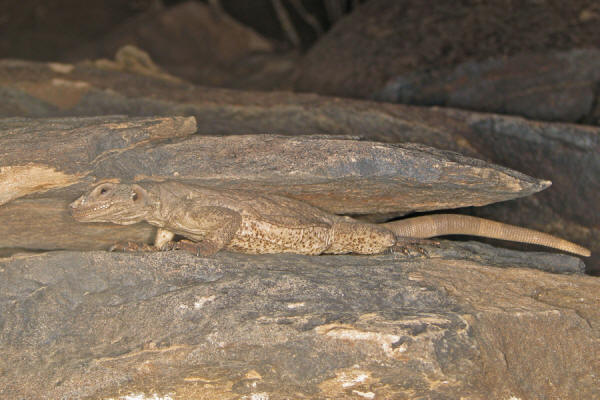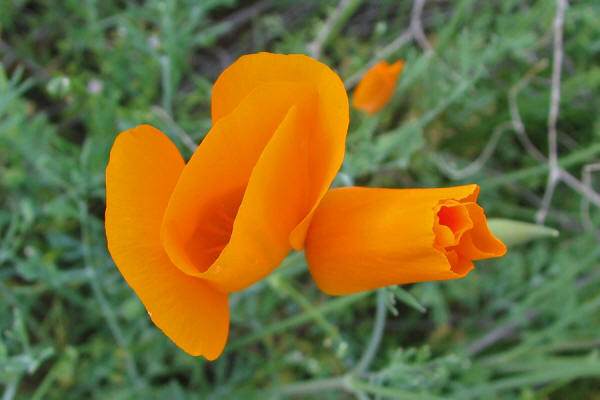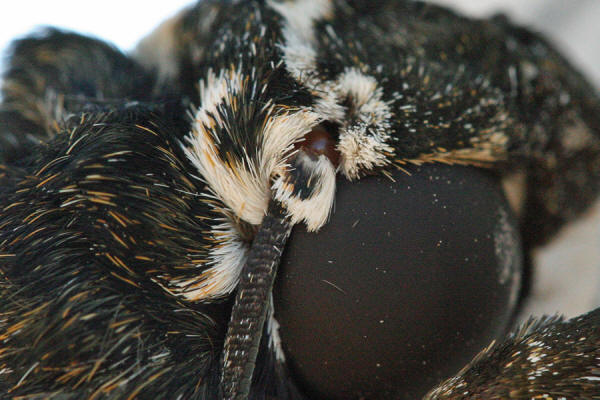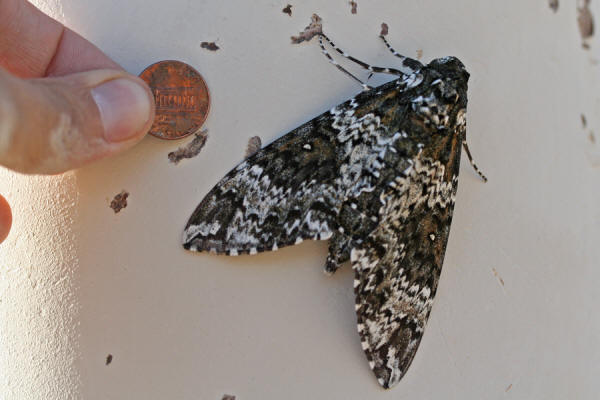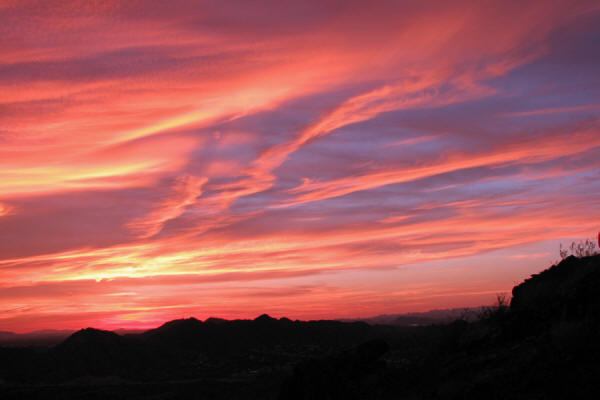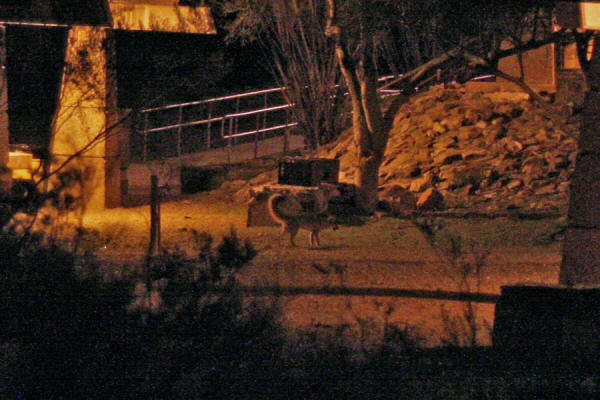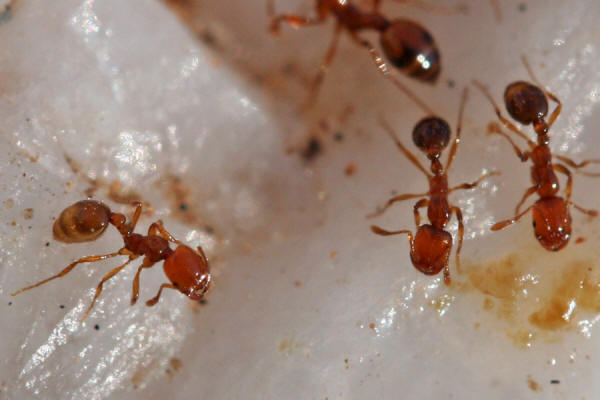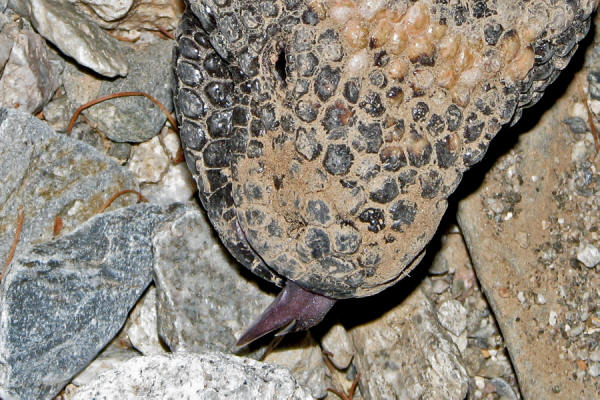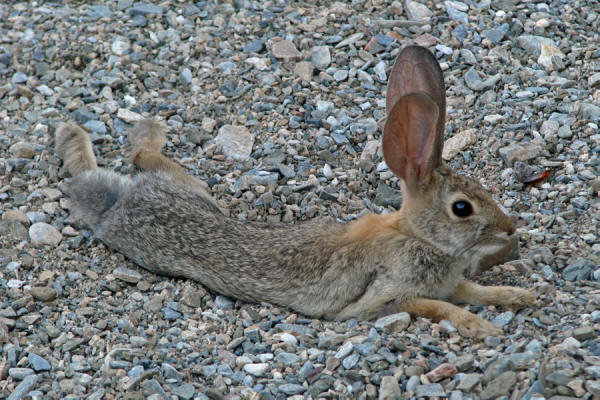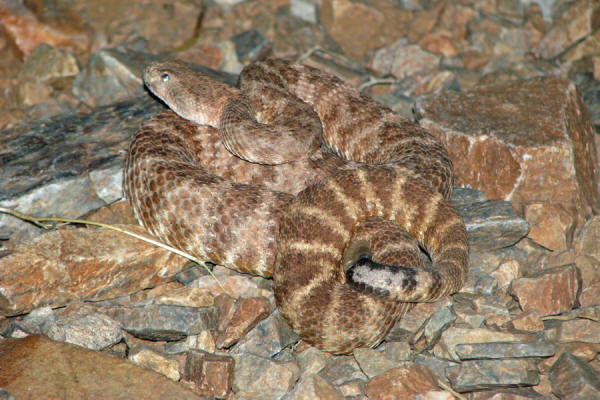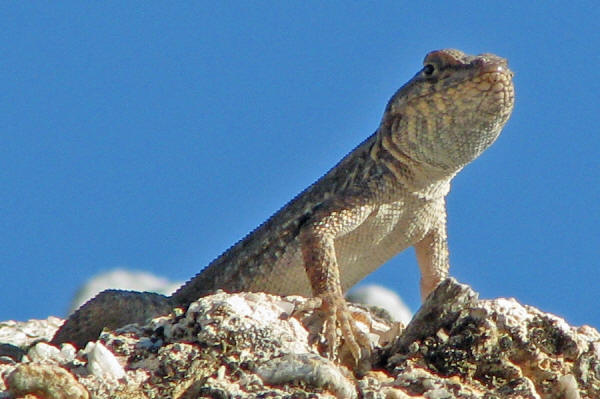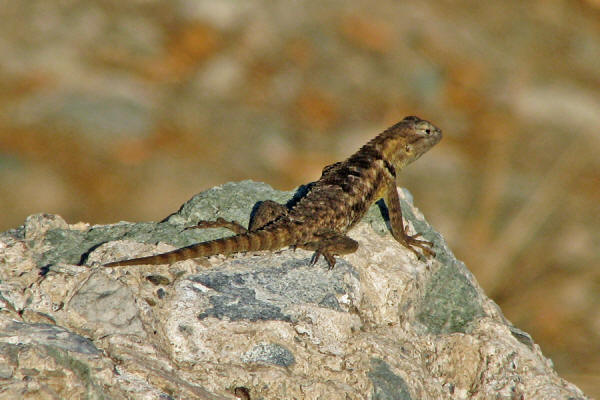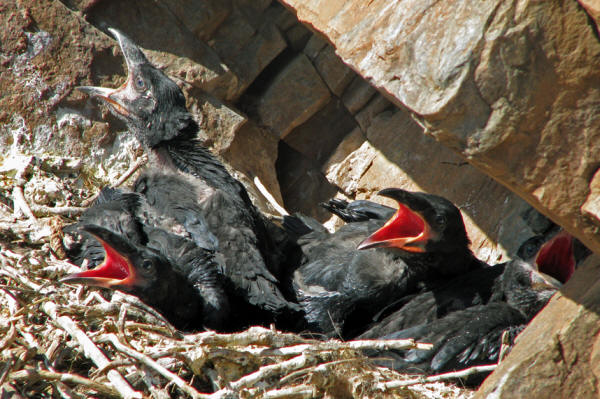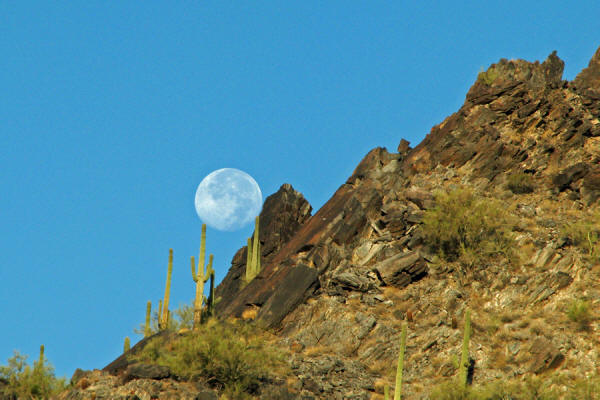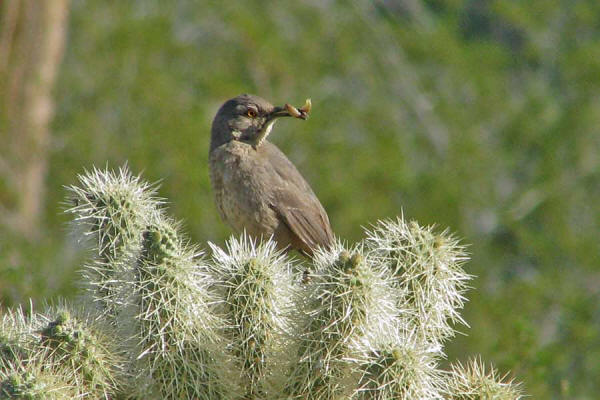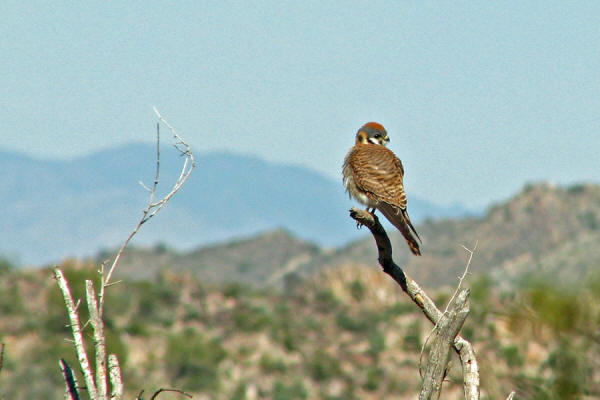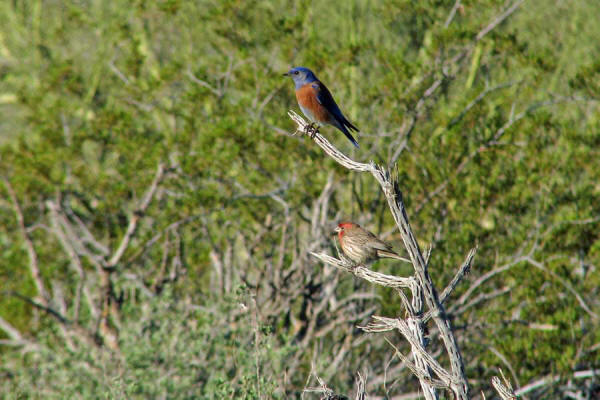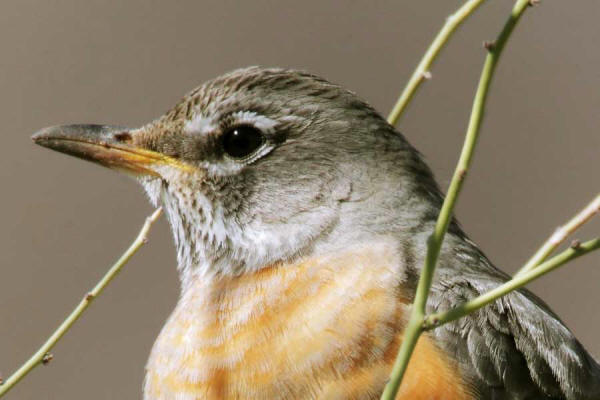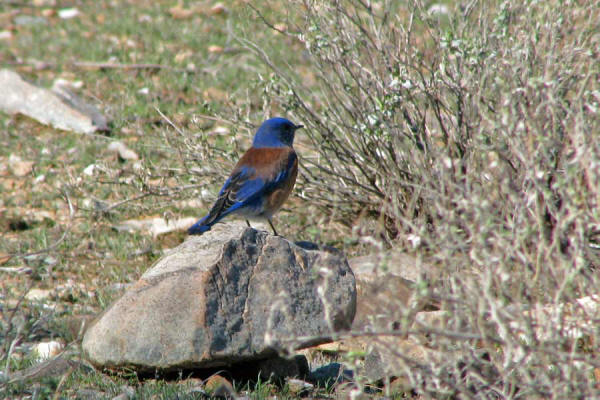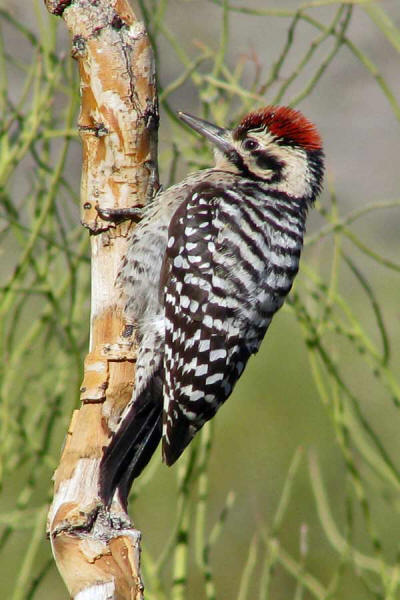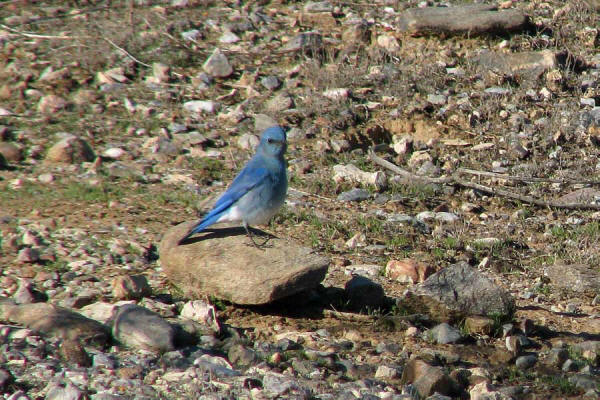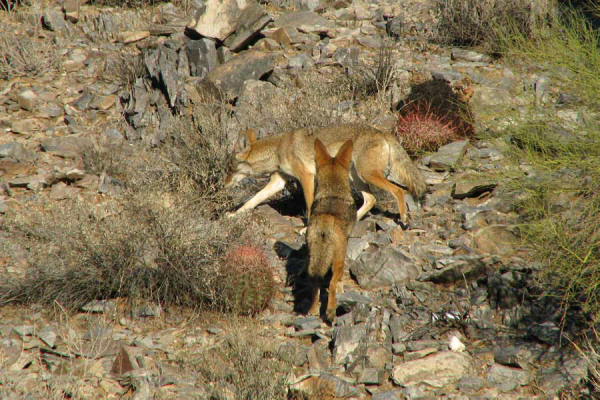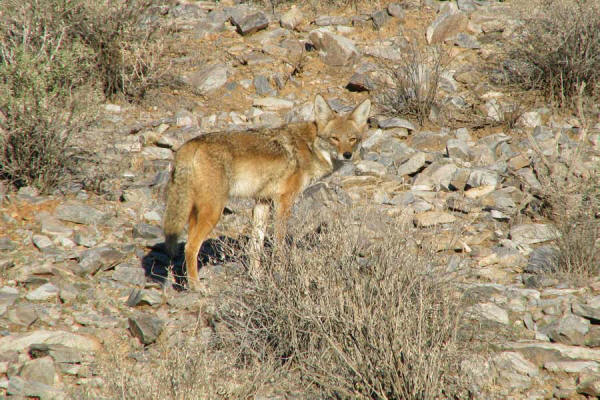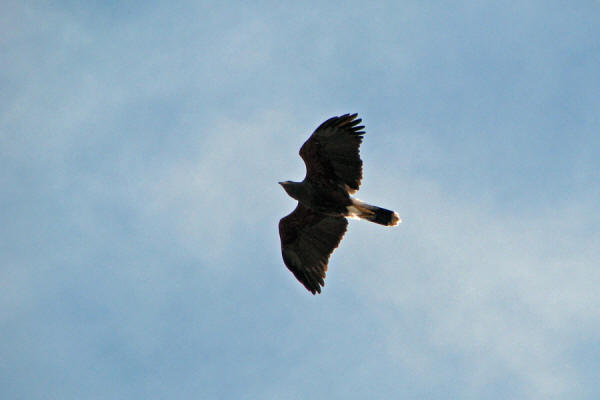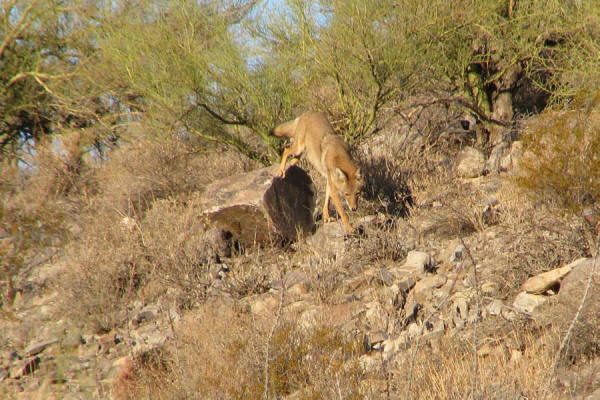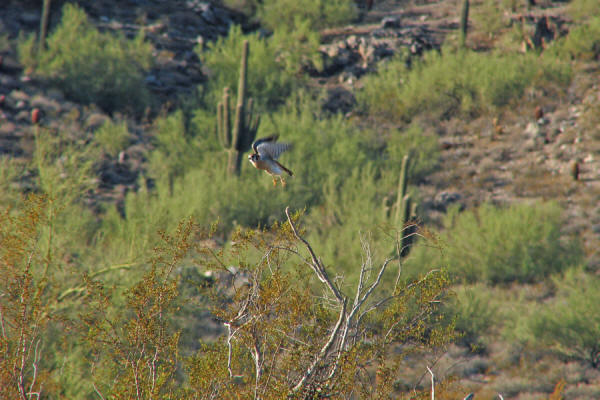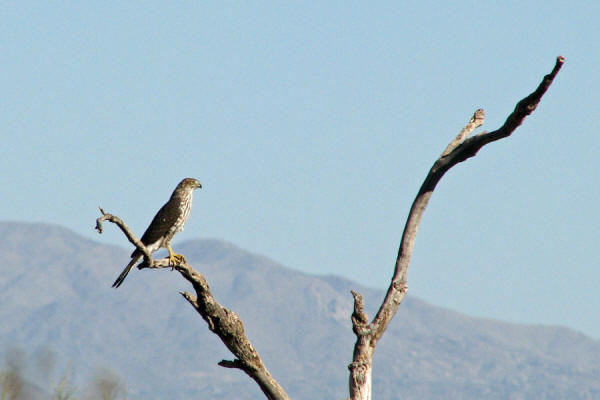- AZJoe
- A peak into the beauty and wonder of
- the Sonoran Desert in Phoenix, Arizona
Daily Page 2 Daily page 3 email: arzjoe (at) gmail.com
Bees who call a Saguaro home
I have encountered several bee colonies out in The Park, but this is the first time that I've seen them using a Saguaro. The others that I have observed were built in the rocks.
At first this looked like some kind of growth living on the side of this cactus. It caught me off guard.
It was fun and interesting to watch this mass move around, and to listen to the intense buzzing going on.
Thank goodness for the bees...
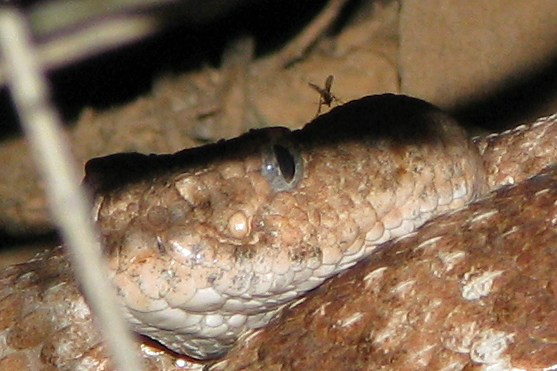
Speckled Rattlesnake with a little friend
This beauty slithered by early this evening, as a friend and I were hiking. I was in front and didn't see this snake. Josh was behind and heard it moving along, scratchy across the rocks. The snake, I am guessing a he, went in under a rock and into hunting position. There he will sit and wait for something to come along, ready to strike should something walk within range. He may stay there for days at a time. This is a good example of the meditation masters in nature.
I loved this encounter for a number of reasons:
1) It is always a special treat to encounter a rattler, especially the lesser common species.
2) The peacefulness of the exchange was extraordinary. The snake never rattled, not even a tiny bit. It means a lot to me when this happens, especially when walking along as close as we did. At one point I was about 3 feet away as the snake passed me in the opposite direction, before Josh spotted him.
3) The tiny fly on his head, as shown in the second image. I barely noticed this in the top image, the chosen one for publishing. As I looked at the other two images from the encounter, the bottom one stood out nicely. The snake's head is about the size of a half dollar, so this fly is tiny.
4) The honor of experiencing the locked-in connection to source that such an animal has. He knows what to do and where to go. He has a finely honed intuitive intelligence. He knows where to setup shop for the next while or so. He knows the core of the earth through his constant contact with the ground, and the kinetic energies that come from moving along its rough surfaces.
He knows. I want to know the way he knows...
Baby Geckos in da house!
Here is one of two baby geckos that live with me in my house, which is about 6 homes away from The Park. I guess we are housemates.
This one is about 2 inches long, and the other is a little shorter. Early on they were tiny and whitish-translucent. At first I thought to catch them and put them outside, but I figured if they wanted to, they could make their way out.
I rarely see them, maybe once every 2 weeks, and never during the day. The only time I catch a glimpse is when I switch on a light in the darkness. They do not take kindly to that action, and speedily scamper for cover.
For some reason, this little one was tolerant of the light, and of the flash from my camera.
It feels good to have these critters running around my house, gracing the grounds with their presence.
Thanks for choosing my home for your home : )
Fishhook Pincushion Cactus Blooms photograph by Joel Pearson
These are some of my favorite plants in all of The Park. They are small, usually between 6-10 inches tall, and they produce some crazy-vibrant little blooms.
Two of the reasons that I like them so much are their predictability and their speed. After a rain, these plants will go into full bloom in 5-7 days. What? Only 5 days to do all that is needed to produce such full and striking blooms!
The bees seem to have a special love for these blooms. I so enjoy watching them explore the insides, diving deep down in, with their little butts sticking up. I can feel their joy and satisfaction as they exploring and work these colorful gems.
Small red fruit starts to appear a few weeks after the blooming has passed. Their shape and color remind me of tiny chili peppers. Inside are thousands of teeny black seeds, each one way smaller than a grain of salt.
Feel the love and the wonder...
Summer rain is a wonderful thing!
What a nice stretch of weather we have been having. It is an excellent example of the power of contrast. The week before the storms hit, Phoenix had a full week of hot, where the temperatures did not fall below 90 degrees.
Still, a lot of storms have come close, then turned back around and left. That has been the story of our monsoon season over the past several years. Thankfully, this year, a number of storms actually made it here, and some of them were significant.
This photo is from a storm that did not make it here, but was close enough to photograph. It was very interesting; an isolated cloud with major activity within. And right next to it was a smaller cloud with similar activity. It was beautiful to watch, and very challenging to photograph. I took over 480 shots in order to get 4 good ones, which comes out to less than 1%! Thank goodness for digital cameras : )
Not your average residential Cricket
This looks like a wild cricket, able to survive in the desert, as opposed to the residential cricket, that prospers in and around human houses.
Look at how huge those legs are! They are almost as high as he (?) is long, and that is just one section, What an impressive array of spikes going down the back of the legs, topped off with an subtle racing stripe.
The appendage in the abdomen looks like a huge stinger, but upon closer inspection it looks flexible. Where it connects to the abdomen are 3 or 4 spikes, reminding me a bit of Triceratops.
When I was shooting this critter, I had to get my camera down very close. Then I noticed how long one of the antenna is, so I had to be careful not to bump into it, and maybe set him off. And with those extra-long legs, he would likely jump a long way, out of my sight, at least at night. Thanks...
click the image to see the amazing detail of this creature
Baby Nightsnake
This is the first such snake that I've seen in The Park. He (?) was very small, about 8".
Click on the image for a closer look...
3 Raven celebrating life and feathers
What a fortuitous encounter! About a block from my house, in The Park, is a smallish pointy peak. This peak is a favorite for some of the larger local birds. Today it was the place for Ravens; overcast and windy, and they took full advantage. They were full of play and frolic, spending a lot of time Sky Surfing and Jousting.
I hung out with them for 45 minutes, which was bliss for me. Rarely do I come across such a lengthy wildlife encounter in The Park. So I sat down on the rocky ground and captured still and moving images.
I've never seen so many soft landings and take-offs before. Sometimes they would just open their wings, catch a few feet of air, and move to a different position, behind another bird. It looked effortless, and so celebratory. (Video below)
Thank you Ravens, for sharing your celebration of life, family, and wind with me...
Raven jousting, with barrel rolls!
What magnificent fliers these birds are.
Dragon cloud or...?
What a wonderful stretch of weather we had a couple of days ago. It felt like another time, as though our concept of time was unable to hold it. It was magical, and it was mystical. What a place this is where we live.
Part of the reason for the magical mystical effects was due to the concept of Contrast. The week previous was our most brutal stretch of very hot weather so far this summer. As high as the highs were, the hardest hit came from how high the lows were. When it is 102 at midnight, it is extreme, and it wears you down.
Then the next day is Paradise. There is no semblance of the previous week. It is a wonderfully wet fall day. How fortunate I feel to have just spent a fall day in The Park, all in the middle of summer. How fun.
This is the sunset from Saturday, July 14. The sky was so active. There seemed to be great ships and characters up there, moving across and above the earth. Is that a Dragon...?
Antelope Ground Squirrel atop a Barrel
A squirrel on a cactus is one of the funnest shots in The Park. Joel and I are always on the look out for it. When it happens, it is usually over very quickly, and all you have to show for it are a few fuzzy images. Every now and then this episode will extend, as it did in this instance. This little critter was up there mining cactus fruit for about 90 seconds.
It is amazing how easily and quickly these Squirrels climb up and around and down the various different type of cactus in The Park. The Barrel Cactus must be one of the easiest ones to climb, with their "friendly" spines that are turned in at the end. I have seen these critters climbing around in Cholla cactus, which have a very sharp and barbed ends. In there, the squirrels climb around with a lot more delicacy.
When you think about it, this is an incredible scene. What athleticism, what toughness, what balance, all in the flow of the day under the sun, part of the beautiful symphony of instruments...
Black-tailed Jackrabbit at sunrise
These critters are one of the easier species to spot. With extra long ears and legs, anytime this animal is on the move, spotting is easy. Looking at the Cottontail below, it is easy to see the similarities. The Jackrabbit kinda looks like a stretched version of the Cottontail.
The Jackrabbit reminds me of the wallaby or the kangaroo. The huge hind legs are very familiar. I have watched and photographed these rabbits standing on their rear feet and boxing, just like the kangaroos. One big difference; with the Jackrabbit, the boxing was very quick and over, too fast to register what happened. When I photographed some boxing Jackrabbits several years ago, and was stunned by the boxing precision that I saw in the captured images, all in a split second. One day I will share the series on Jackrabbit boxing. I am thinking of calling it "Fight Club Jack".
Cottontail Rabbit showing off the cotton
This critter represents some of the more adorable presence in The Park. They seem so fragile, yet they are far from that.
These furry little animals are tough, fast, and quick. They will eat Cholla cactus if they are thirsty enough. They can outrun any human, and they are quick enough to evade many a coyote.
They also love to play games with each other, beyond the usual chase. One game could be called Split Jump; Two cottontails face one another, about 6 feet apart. Suddenly one runs right at the other, at high speed. The other rabbit just sits there and waits. At the last moment, the second rabbit springs straight up into the air, and the first rabbit runs right underneath. I have seen them do this many times in a row.
This type of play illustrates to me the great joy that animals experience in the wild. Observing them using their physicality and reactions at such a high level reminds me of playing spontaneous games as a child. Oh the bliss of it all : )
Wet baby Barrel Cactus
How I love being in The Park during and after a good rain. This image was captured back in March, after one of our rare downpours.
Each time I am out there when it is wet, I stop to capture images of the Barrel Cactus. Their tines turn so red, like there is blood coursing through them. There is this illumination that isn't present when they are dry.
Speaking of rain, it has been a long while since we have had a good soaking from the heavens. The Park is as dry as I can remember. The color brown is so dominant right now, with little green. This is very rough on all of the life in The Park, from the plants to the insects to the critters. It is so bad that the animals are taking to eating cactus, not for food, but for water. This further destroys the plant life, which is the basis for all life in The Park. It hurts to see this happening.
Hopefully we will be blessed with some great rains later this summer. I sure hope so...
Great Horned Owl taking flight
I went for a walk in The Park the other evening. At one point I looked up to the left and saw this critter perched on the rocks above. She (?) was peacefully looking around, taking in the sights and sounds that surrounded her. I like how she has some resemblance to a bat in this image.
Owls are one of the quietest flyers in the world. They have special sound-deadening feathers incorporated into their design. These give the owls an especially stealthy hunting posture. I wonder how many small animals became owl food because of this feature, where otherwise they would have scampered in time.
It is interesting to notice the different tools that are in use in the natural world. Others that come to mind are: the Zone-tailed Hawk that looks like a vulture; the Wind Scorpion with the large 'arms' that look like a scorpion's claws, and the butterflies that have faces painted on their wings, so that when they are sunning, they look like something with large eyes. The wonders...
Tarantula Hawk Wasp on the hunt
What an energizing encounter this was. This lady was out at the end of a long summer day, not slowing down a bit. She was busy doing her job, and in a most relentless fashion. What a very interesting job she has. So what is her job?
She spends her days hunting for tarantulas. She flies for a ways, then she lands. Once on the ground, she is on the move, looking for any signs of a tarantula. She goes into any holes that are around. I wonder how many times she checks out a hole before she finally finds what she is looking for; 5000 times, 10000 times, 20000 times?
All of this movement also makes her one of the most challenging critters in The Park to capture an image of. It is rare that she will stop for more than one second, then she is out of focus again.
Thank you oh colorful one for sharing with me...
Keeley and Carson, my niece and nephew
I was going through some older photos when I found this image from a few years ago
Here Keeley demonstrates the peace and tranquility that can result from a meditative posture in a natural setting. Carson generally wants to do what she does, so he is back there, enthusiastically supporting her.
Nature deficit in children is at an all time high, and the consequences appear severe. The calm and peace that can come from time spent in nature is a great value that so many are missing out on. There is also the appreciation of nature, and of the resulting caring for nature. This caring can carry over to their everyday life, bringing a kinder and gentler spirit with them.
The next best thing to being out there is to enjoy images and videos of the natural world. These can warm the soul in a wonderful way. It is not the same as getting out there, but sometimes it is a lot easier to do.
Hooded Oriole, Male
What a delightful encounter this was. I was walking along a trail in The Park near my house, an hour before sunset. About 90 feet away I noticed a bird atop some Saguaros, digging into some buds. At first I dismissed it, thinking that it was a Mockingbird, with the white slash across a black wing. I did notice the yellow color, but figured it had to do with the setting sun. I looked a couple of more times I decided that there was just too much yellow for it to be The Sun, so I started shooting away. Good decision...
I have only seen the Hooded Oriole twice in The Park before, and the new images are way better. It helps to be a mere 90 feet, instead of 150 feet away. Thank goodness for long zooms!
It feels great to have some Oriole images that are worthy of printing. I love the fact that he is on a budding and blooming Saguaro cactus. I just did an image search on Google, and none of the hundreds that I saw had a Saguaro in them. I love the Sonoran Desert shapes and energy : )
My first rattlesnake sighting of the year!
I love me some rattlesnakes, and today I was blessed by the presence of 2 of them. They were both Speckled Rattlesnakes, and they were both on the same trail, about 25 feet from one another. They each gave me a bit of a rattling, and my soul jumped each time.
The first was a bit scared, and slid in under a rock for cover. I didn't get any shots of that one. The second one was more relaxed, and went on hunting after a few minutes. I was able to videotape some of that movement.
As much as I love rattlesnakes, they shiver me timbers like no other animal in The Park. The scariest part of them is their ability to cloak. There have been times when I was looking for them, and couldn't see one that was a few feet in front of me. I've unknowingly stepped right over them before.
If you have the fortune of encountering one of these ancients, please leave them in peace : )
Speckled Rattlesnake hunting
Chuckwalla hanging out under a rock
This lizard was well hidden as I strode by. I only saw him because his front foot was sticking out from under the rock a little, and he moved it.
These reptile spend a lot of time in crevices and under rocks like this. They seem to feel most comfortable in situations that would seem way too tight for most other animals.
I love how they seem to take on the color of their surroundings. It almost seems like they can do that Chameleon thing. Not sure if they can change their coloration even a little.
I have another idea of how they have such genius camouflage. I think that they stay in the same areas for generations. The first ones in slowly adapted their coloration to match their particular surroundings.
Same Chuckwalla hanging out under a rock
When I first saw him, all I could see was that front foot. It is considerably darker than the rest of the leg, so it stood out some.
If you click on the photo, the large version better shows the wonderful camouflage abilities of this critter.
Chuckwallas can have a wide range of color variations, even in the same area. Some are brightly colored while others are very muted, like this one.
I wonder how much this species has changed in the past 1 millions years. Maybe that is a short time in the history of this critter.
I do love our reptilian brother and sisters...
Anna's Hummingbird and her lovely Ocotillo bloom friends
The Hummingbirds sure love these particular cactus species. It is lovely to watch them work each of the blooms, with precision and speed. I get the feeling that the nectar from this flower tastes amazingly good to these fearless flyers, kinda like the bear and honey.
They also use the ocotillo branches for perches quite often.
The 'thorns' of this cactus are not thorns at all, but leaves that are rolled up tight. These have gotta be some of the sharpest leaves around!
I love it when I see contrasting colors working together in The Park...
Mexican Poppy, Feb 24, 2008
What a glorious spring we had back in 2008. There is nothing like a great abundance of Poppies.
From afar, they look pretty much the same. Looking closely at them, many of them were drastically different from the others. Some, like these, were orange, while most of the others were yellow.
Oh what a time that was...
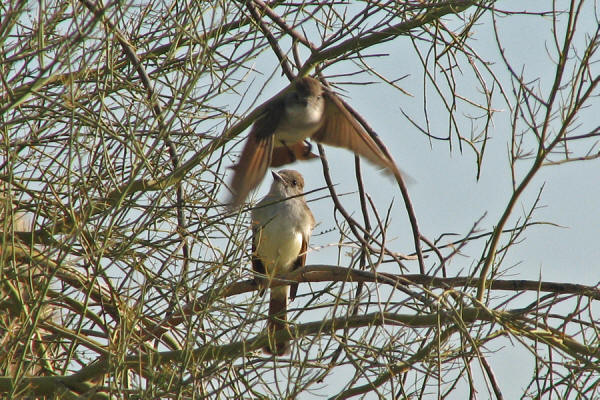
A pair of Ash-throated Flycatchers
These birds are one of several different types of Flycatchers in The Park. They are elegant and acrobatic flyers, and are a lot of fun to watch.
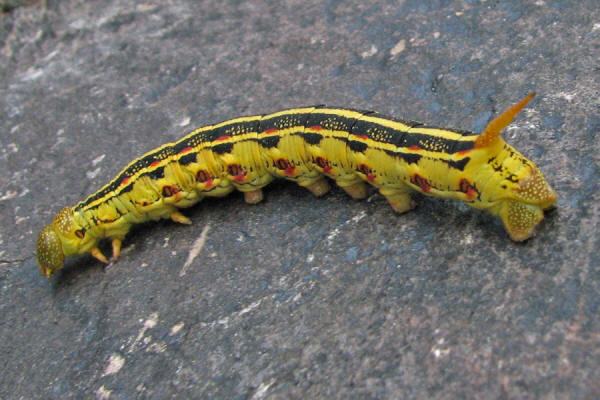
Larva of the White-lined Sphinx Moth
These critters were out in force on 9/08/08. I must have seen thousands of them. They were around for a few days, then they were gone, and I haven't seen them since. They were about 3.5 inches long.
Thanks to my friend Walt Anderson (GeoLobo.com) for identifying this critter for me. I had originally suspected that it was the larva of a Rustic Sphinx Moth, as shown below.
The coloration of this caterpillar is impressive. The accenting use of red against the yellow and black is really beautiful. I would love to know why they developed such a complex color pattern. Look at how odd the legs are. In the front they are spindly, and in the back they are like pillars with suction cup ends. When I print this image to 6' long, it looks like a creature from another planet.
Here is a link to more info on the White-lined Sphinx
You never know what you are going to get in The Park. Fascinating...
Antennae socket
This is one of the most important parts of this critter; an eye and an antennae socket.
What kind of critter is this?
It is a Rustic Sphinx Moth, about the size of a closed fist.
There is an image below for scale.
This is the only time I have seen this critter, and boy did he stick out.
Click on the photo to see the fine detail of an eye and antennae socket.
I love the colors of the "hairs", and how they are distinctive yet blend very nicely. I also love the wavy patterns, like a flowing river, with areas of turbulence and everything.
Fun...
Rustic Sphinx Moth
This is certainly the biggest moth that I have ever seen.
It was hanging out on one of the light poles by the Rangers Station.
I love the myriad of designs on his back. It get even more intense the closer in you go.
Click for more info on the Rustic Sphinx Moth
Such a sunset, 8-12-08
Looking back through the archives for images to share, I came across this beauty, just over 3 years ago.
We sure get our share of brilliant 'paintings in the sky', either first thing in the morning, or at the end of the day.
I love the way the colors change as the seconds tick by. Brilliance fades to muted...delicate colors mixing and blending.
How lucky are we...
Gray Fox
This is the only image that I was able to capture during my first Gray Fox encounter in The Park.
I love the fact that these elegant animals are out roaming The Park, in both the daytime and at night. Whether or not they live here, or just visit, is beyond my knowing. I like to think that they do indeed call The Park home.
Thank you for gracing us with you magnificent presence.
Grey Foxes out walking a ramada
This is the second Grey Fox encounter that I have had. There were 2 of them making their way around the picnic tables. (1-08-10, 9pm)
The way that they walk is so beautiful, so elegant, so flowing...like from a different planet, or something. Those tails are so long and expressive...mesmerizing.
I hope to capture some clear images in the future, but for now this is what I have to show. There sure are a lot of interesting characters that make up the whole of this incredible space.
...such an experience...
Tiny Ants doing their thing
These are some of the smaller ants, about the size of a small grain of rice. They are some of the busier critters in The Park. One of their main jobs is cleaning up messes left by other animals. Here they are taking in the remains of an odd gelatinous mass that I encountered...I am not sure what it was or who was responsible...it was a new site for me. It was on a rock and was about the size of a hot dog cut in half. When I came back later, it was gone, and I then photographed the ants. It seemed like something that an animal ate, then it came back up, was left out, then was eaten again. My best guess is a coyote.
The Park is full of mysteries : )
Just like their snake cousins, Gila Monsters use their forked tongues to smell the air for potential food opportunities.
Sometimes they will flick their tongues rapidly, and one can sense their excitement of a possible meal lurking nearby.
Click on photo to see the split tongue more clearly.
Cottontail
This furry beauty was cooling off and relaxing during the late afternoon. I love how he just flops his feet back behind him, getting his whole under-region in contact with the earth.
Speckled Rattlesnake
I encountered this beauty just before 8:30 pm in the middle of June. I am fascinated by how these long and narrow creatures can blend so magnificently with the surroundings. Even when I am walking slowly and looking for them, I will often miss seeing them until I get too close. Then they either move or rattle, or both.
Most of my encounters have been peaceful, without any rattling at all, or just a tiny bit. Now and then I will come across one that is all worked up, and I will get an earful of rattle even when I am a good distance away.
I always feel privileged and honored to have a rattlesnake encounter. There is something mystical about them.
Common Side-blotched Lizard
I love getting low perspectives of the desert's ground dwellers. It throws the scale way off, and can make them appear more as dinosaurs than as common critters. I am still amazed at how fast these four-leggeds scamper, and how well they climb.
Lizards seem to be plentiful this summer. This is a good sign, as these reptiles are a key food source for many of the larger birds, like the Road Runner, American Kestrel, Cooper's Hawk, Red-tailed Hawk, and more.
Velvet Mite
The Velvet Mites are quite the mysterious characters. They only seem to come out after the rains in the summertime, and only sometimes. I didn't see them at all last year. After the big rain we had the other day, they made an appearance, yay!a
Notice the tiny 'glass' eye...there is a reflection off of it. I tried to get better shots of the eyes, but this critter doesn't like to stay still.
Click on the photo for a larger version. recently, alas they made an appearance.
Velvet Mite
Here is a short video clip of the Velvet Mite above. In an isolated view like this, one can envision this critter on another planet...making way through his day.
I find it curious that the color is so bright. These bugs really stand out against the desert floor. Why the need to have such a 'screaming' color? Maybe they are somehow yucky to the usual predators, and the red color makes that clear.
Something more to explore...
I encountered this handsome bird a few blocks from my house, where The Park juts out to the north. I never realized how fully patterned the breast is, completely covered in brown designs...they look a bit like they are swimming downwards.
I love the eyes of the predator birds. They seem so wide opened, taking in so much of what is going on around.
It looks like this bird spotted something, and is taking a step to set-up for take-off. Maybe lunch today will be a quail, or a dove, or...maybe it will be a Spiny Lizard, sitting out in the open on a rock, like the one below...
There seems to be an abundance of lizards out this summer. That is a good thing for the ecosystem, for two reasons in particular. They eat a bunch of bugs, which helps keeps them in balance. They are also eaten by larger animals, like the Cooper's Hawk below. I bet they are also a dining favorite of the Road Runner, 2 spots below.
I have been wanting to capture this particular action for some time now, and today was the day. I heard a pair these speedsters clacking this morning, but couldn't see them. After about 12 minutes I noticed them atop a rocky knoll. Just as I saw them, one flew down into the west. I was sure the other was about to follow so I started recording video. After about 9 minutes of this, this great bird took off and glided down, in the opposite direction of the other.
Of all the times I have seen them fly, almost all have been gliding down like this. One interesting note; the wing-flapping at the beginning looks like the flapping of the Mockingbird, who happens to be the star of the next video.
Mockingbirds seem to love to relentlessly harass other critters. This is the first time I have ever seen this done to a Coyote. It looks like that bird nipped the canine in the butt several times. I wonder the reason for this behavior. The Mockingbirds seem unable to help themselves when an opportunity comes along. It sure is fun to watch, though I feel a bit cringy for the coyote, who looked a bit stressed to begin with.
These 4 young Ravens got a surprise visit when a female Anna'a Hummingbird came along. It looks like she thought that red color in one of the mouths was a flower. I wonder...if the bird would have stuck her beak in, would the baby have chomped down on her, thinking she was food from Momma? I figure the quick Hummer would have avoided that easily..
This is another example of how fun and interesting it can be when 2 different species come together.I find such interactions magical.
How many wonderful such situations are taking place throughout The Park on a daily basis. Imagine the different possible combinations of animals coming together, face-to-face.
This is a magical place...
These youngsters spent their formative weeks just under the highest point in The Park. I have been told that they open their mouths to let out heat, as well as the eating thing.
I enjoy watching and capturing images of the Dancing Moon...seemingly prancing along and down the profile of the mountain, being caressed and held by the rocks and cactus as she does. I love it when the celestial and the earth meet...something deeply calming and peaceful.
click any image for larger version
Here he is again, old yellow eyes. Not sure what kind of worm or caterpillar that is in his mouth...that squirmy is a part pf a whole other world that exists out in The Park; the bugs and the micro organisms.
These tiny critters are crucial to the lives of the wildlife throughout The Park. Preserving their habitat is essential for the wildlife that The Park supports.
We had been hoping to see another Kestrel, so it was with excitement that we photographed this beauty. She was busy flying around the desert looking for something to eat. She did capture a tidbit, but we were unable to identify what it was. We have seen them eat a caterpillar and a lizard before.
These are the smallest falcons in North America, about the size of a White-winged Dove.
click on any photo to see a larger version.
Well, the Blues are still with us. It has been 7 weeks since our first encounter, and they still seem to be loving it here. It makes us wonder if they have set up shop in The Park, with nests and all.
I love getting 2 different species in the same shot. There is something about the contrast and compare, especially when they both have some nice color going on. The Finches and the Sparrows seem to enjoy having the Bluebirds around...often times we will see them hanging out with the colorful visitors.
They have arrived, and they seem to like it here. It has been a few weeks now that the Robins have been running around The Park.
The American Robin is normally found in the higher elevations, so we are glad that they decided to visit, and to hang around for a while.
This looks to be a couple, with the male on the right and the female on the left. As with many bird species, the male has more color than the female.
Thanks for visiting us oh flitty ones...
What a beauty. Such delicate feather patterns on her head and breast. She almost looks frosted. Click on this image to better experience the intricate beauty
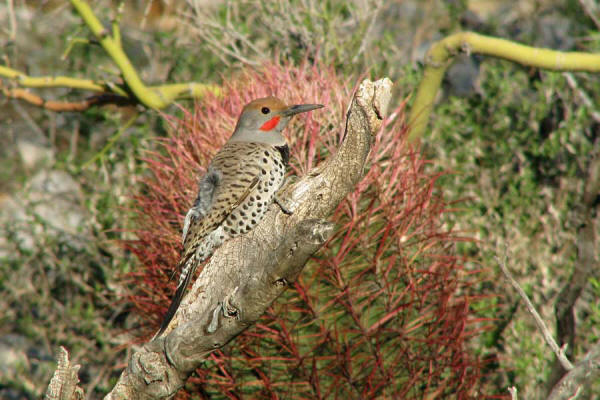
Here is another of The Park's great beauties. You can tell he is a male by the red face paint. All 3 varieties of woodpeckers in The Park use red to mark the males, with the Gila and the Ladderback marking the top of the head.
This guy was busy pecking on this snag. I can't figure out why. It didn't seem like he was doing it for insects, more like he was just doing it to do it. Maybe it helps keep his beak ready, or maybe it just feels good. I think it is because it feels good on his brain. Anyway, it was sure great to watch and hear him go about it.
Below is a video clip of the pecking in action.
Here he is again, just after take off.
In this shot it is easy to see why they are called Gilded, with those magnificent golden color on the underside of the wings.
Here he is, doing that thing that woodpeckers do, peck.
I love how fast they do it, like a jackhammer. I wonder how it works. One thing that I do know is that I love watching and hearing it go on.

Today provided quite a treat...an encounter between a couple of raptors that live in The Park.
First we saw a large Great-horned Owl perched in a snag. All of a sudden she(?) started fluffing up and squawking loudly. At first I thought it was because of us, then we spotted the real cause for the ruckus; a Cooper's Hawk had flown into the same snag. Apparently the Owl had come a bit too close to the Hawk's territory, likely close to the nesting area.
Here is a photo of the two of them in the tree...the Owl in the lower left corner and the Hawk in the upper right corner.

Here is the Owl getting all worked up because the Hawk just landed in the same tree. The owl started making a bunch of noise, but the Hawk didn't seem to mind at all. In fact, the Hawk flew in closer to the Owl.

Here he(?) is, about to move in closer to the owl. His tenacity on driving the Owl out was most impressive.
The Hawk ended up chasing the Owl out of the snag and about 100 yards away. A bit later the Owl flew again, with the Hawk right behind. This happened several times.
Here is a short clip of one of the chases. It looks like the Hawk actually touched the owl here. We did notice on an earlier chase where there was definite contact.
These chases kept happening till they were finally perched in the same Palo Verde tree, several hundred yards away from where it all started. After a few minutes in the tree, the Hawk flew away, leaving the Owl in peace. Apparently the Owl was far enough away to put the Hawk at ease.
What a fun day in The Park.
It has been great fun watching and observing the pleasant Western Bluebird these past 3 weeks. One of the best parts is when they fly. That's because when they fly away from you, all that blue on their back side lights up, at its maximum. Experiencing such a dynamic flash of blue in the winter desert is quite a tasty treat.
This photo illustrates the amount of blue on the back of the male. When he takes off, he appears to be saturated with blue.
click on the photo for larger version
It is always a treat to come across one of these beauties. The Ladderback is one of 3 woodpecker species in The Park. These are especially active, and spend a lot of time on the ground.
Ladderbacks have one of the most interesting pattern designs of any critter in The Park. There is the swirly face paint, which reminds me of the middle of a rolled ice cream cake. Then there are the delicate white spots on the front of the red cap, like paint splatter from a fine brush. Then there is the back...so much going on there...the stripes, the dashes, and the spots...oh my!
What an impressive and fascinating outfit you are wearing Mr. Ladderback!

White Crowned Sparrow
The White-crowned Sparrow sure looks regal. They are common in The Park, but I rarely get a good shot at one, so this was a treat.
We experienced a Blue invasion today. About 15 Western Bluebirds rolled through The Park, and we were fortunate enough to be there. They were great models, seemingly posing for us, and glad to let us get pretty close. What a great addition this is to our list of wonderful critters found in The Park.
The top bird is a male Western Bluebird, and the bottom bird is a male Mountain Bluebird. I hear that it is quite rare to see a Mountain Bluebird in the desert. It was very interesting how he was flying with the Western Bluebirds, like somehow the Blues like to stick together.
What a beautiful experience. So much color and such a presence. We are hoping to get a few more such experiences , but this may have been it.
Thank you blue beauties, for stopping by and for being so friendly.
Here is a link to a site with some nice Bluebird information: Arizona Birds
What a fun encounter this morning when we came across a pair of beautiful Coyotes meandering along. I can't remember when I have had such a relaxed experience with this canine species. After Joel and I happened upon them, they slowly walked off, without the usual alarmed trot that we normally get.
The bottom one had one of the richest coats that I have ever seen. He(?) even has a fox-ish look to him.
It was great to see two healthy and seemingly contented Coyotes in The Park. It is a good sign that all is well with the eco system.
Thanks for taking your time with us today.
This is the first Harris's Hawk that I have seen in The Park. At first I thought it was a Zone-tailed Hawk, the only other black bird that flies the way a hawk does. Later it was pointed out to me that it is most likely a Harris's, and was later confirmed.
I am glad to be able to add this magnificent creature to the list of animal images captured within The Park.
Thanks for the show.
Harris's Hawk
Here is a photo of the Hawk from the video above.
This Thanksgiving was full of predator sightings. First off was a nice pair of coyotes. We were tipped off to their arrival by a couple of jackrabbits that were running along in an unusually speedy fashion. The coyote in the photo stood up on the rock hoping to get a glimpse of them, but they were out of sight by then. The coyotes moved quickly down the mountain to the flat areas, and were soon out of sight.
The male American Kestrel was perched inconspicuously on a branch several hundred yards away when Joel caught a glimpse of him. We tried to get close enough for some good shots, but he was having none of it. I was fortunate to capture an image of him just after take off. He flew a long way, well out of our range to follow. Still, it was a pleasant sighting.
The Cooper's hawk came along towards the end of the day. He(?) flew right in front of us, and landed somewhere behind some trees. We tried to find him, but nada. Then he flew right in front of us again, staying low over the wash. He landed on the snag in the photo. I was fortunate to get off several shots before he moved on and out of sight. They have some of the 'brightest' eyes around.
The red-tailed hawk came flying towards us just as we were finishing it up. We were able to get some decent shots as she(?) circled overhead. I love that red tail of hers.
So that is what Thanksgiving morning held for me and Joel, and it was a very nice one indeed. We have had a rich year of wildlife encounters in The Park so far this year, including 3 desert tortoises, 3 long-eared owls, and 2 Gila monsters, to name a few highlights. We saw none of those today. No, today was ruled by the these 4 wondrous creatures, further enriching our lives and deepening our love for The Park.
Thank you to all the animals who live above, on top of, and below this magnificent Sonoran Desert landscape. Thank you for giving us glimpses of the great wonder and beauty that exists in the world of wildlife. Thank you for showing us what it means to have a deep connection with the earth, and for demonstrating what a balanced life is really like.
Click on any of the photos for a larger version.
Here he is again, good old 'No Ears', this time in video.
There is nothing quite like having a good stare with a Great horned Owl. I think they have the most potent eyes in The Park. These are especially so, with the engorged pupils.
I love the way that he sometimes blinks both eyes at the same time, and sometimes only one. I also like his head movements, how precisely he moves when he looks up and back down...like a magnificent machine.
We haven't seen this fellow in the park lately, and very few Great Horneds, for several weeks now. Maybe they moved to another part of The Park after depleting the local squirrel and mouse population.
I encountered this creature during his final struggle with life. He(?) had lost two legs on the right side...not sure how. He was expending great effort to do what was easy for him before. To make things worse, he kept flipping over, and would take desperate trials to flip back.
I hung out with the little guy for about 10 minutes. I was very impressed with his exceptional strength and persistence...two admirable qualities in any creature.
I love learning from and being inspired by the wildlife in The Park. From the awesome Red-tailed hawks and Great horned owls that rule from the air, to the ancient Gila Monsters and Desert Tortoises and lug on the ground, all the way down to the crawling bugs, there are lessons to experience, life to revere. It is simply a matter of taking the time and the humble perspective to let their light shine on me.
Thank you for sharing your lessons, and some of your last moments.
all images on this page copyright 2008, 2009
Email address Joe(at)AZJoe.com



